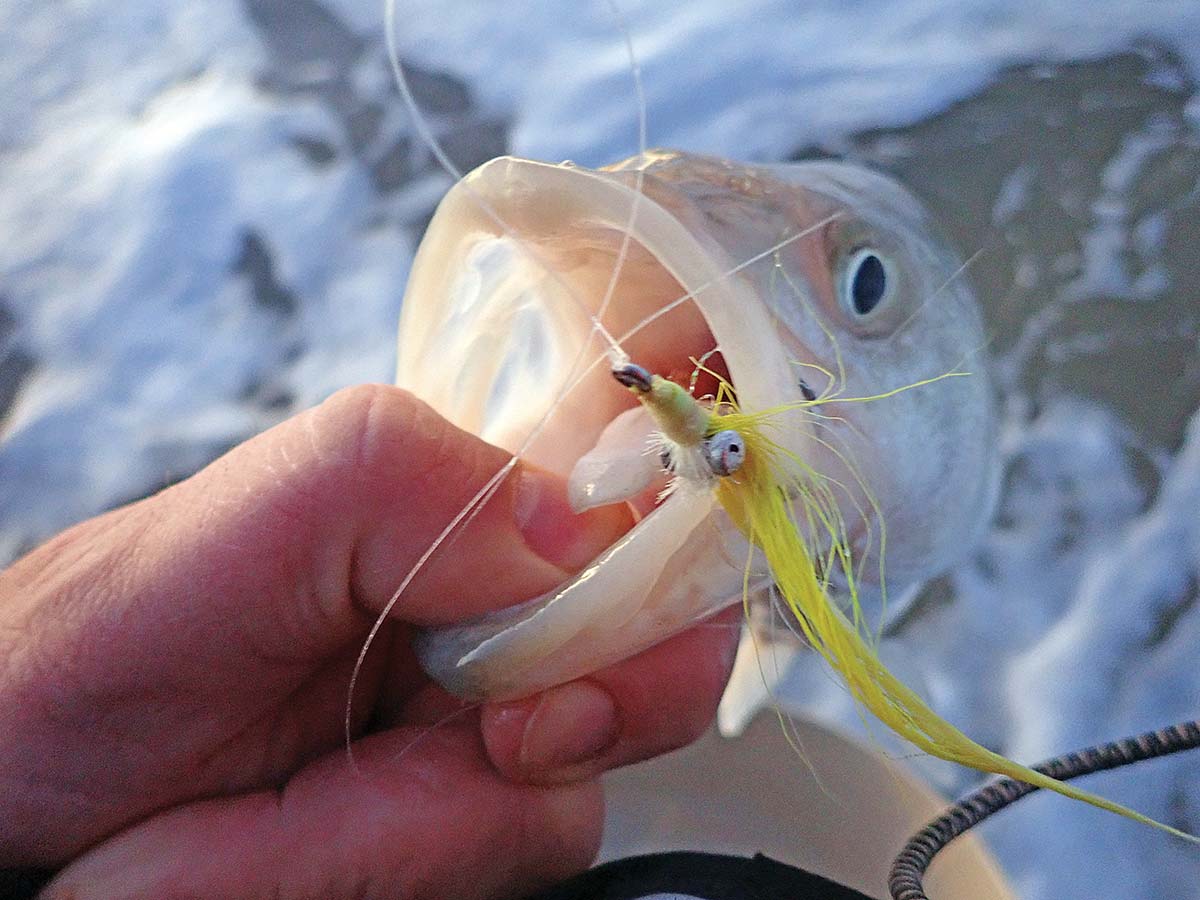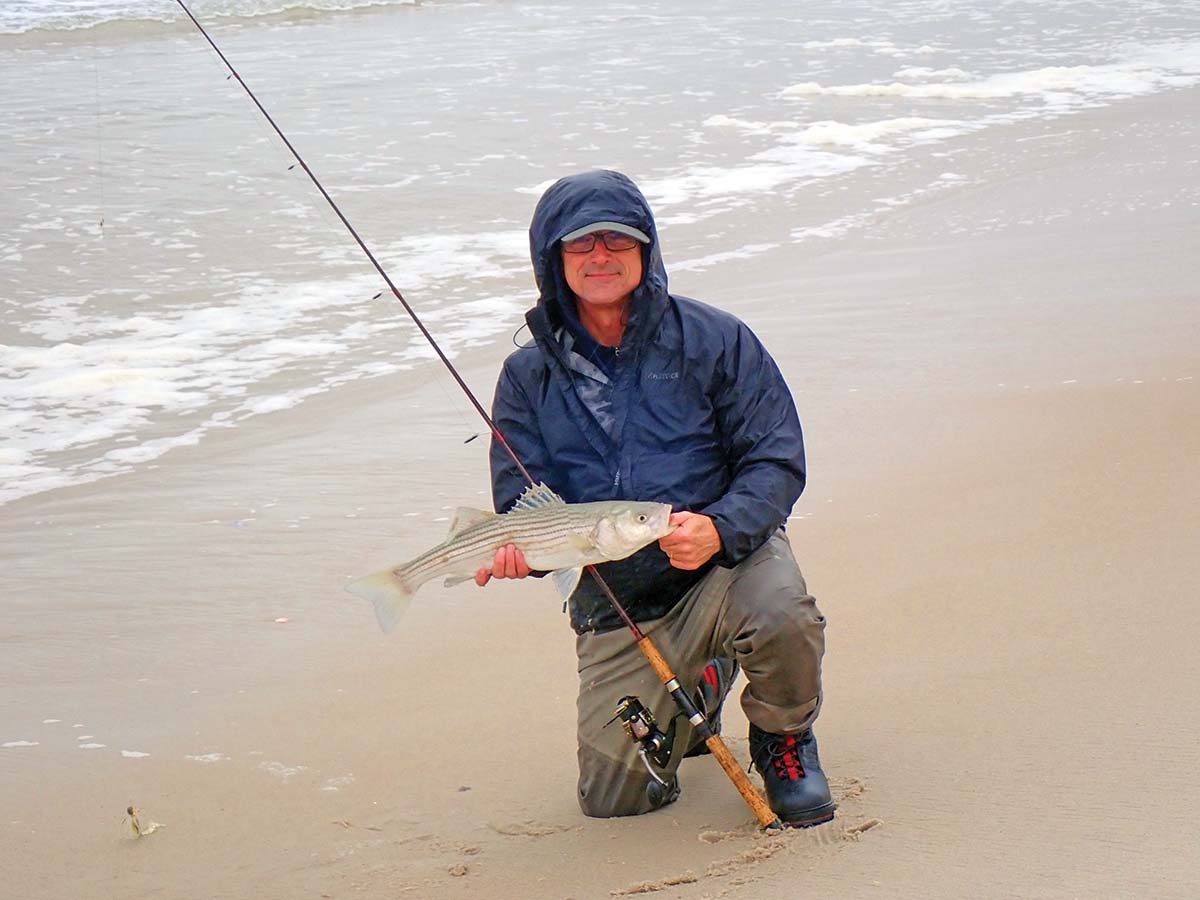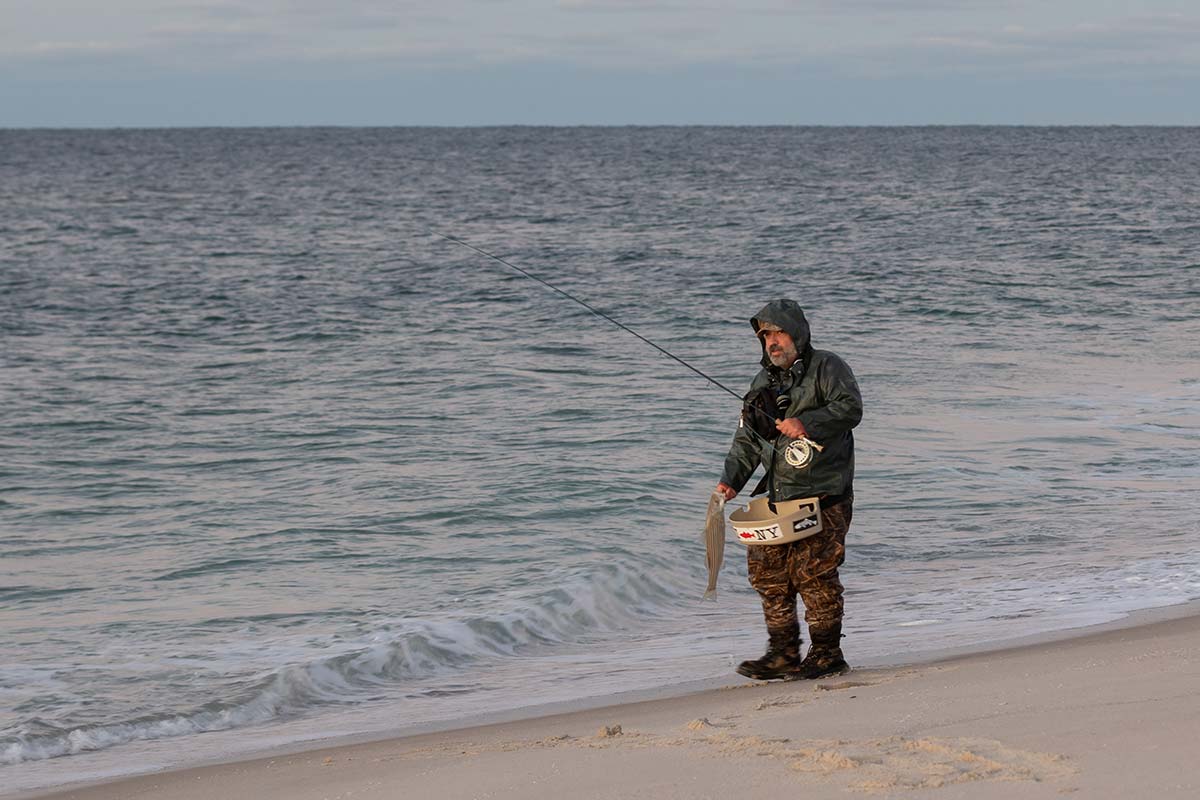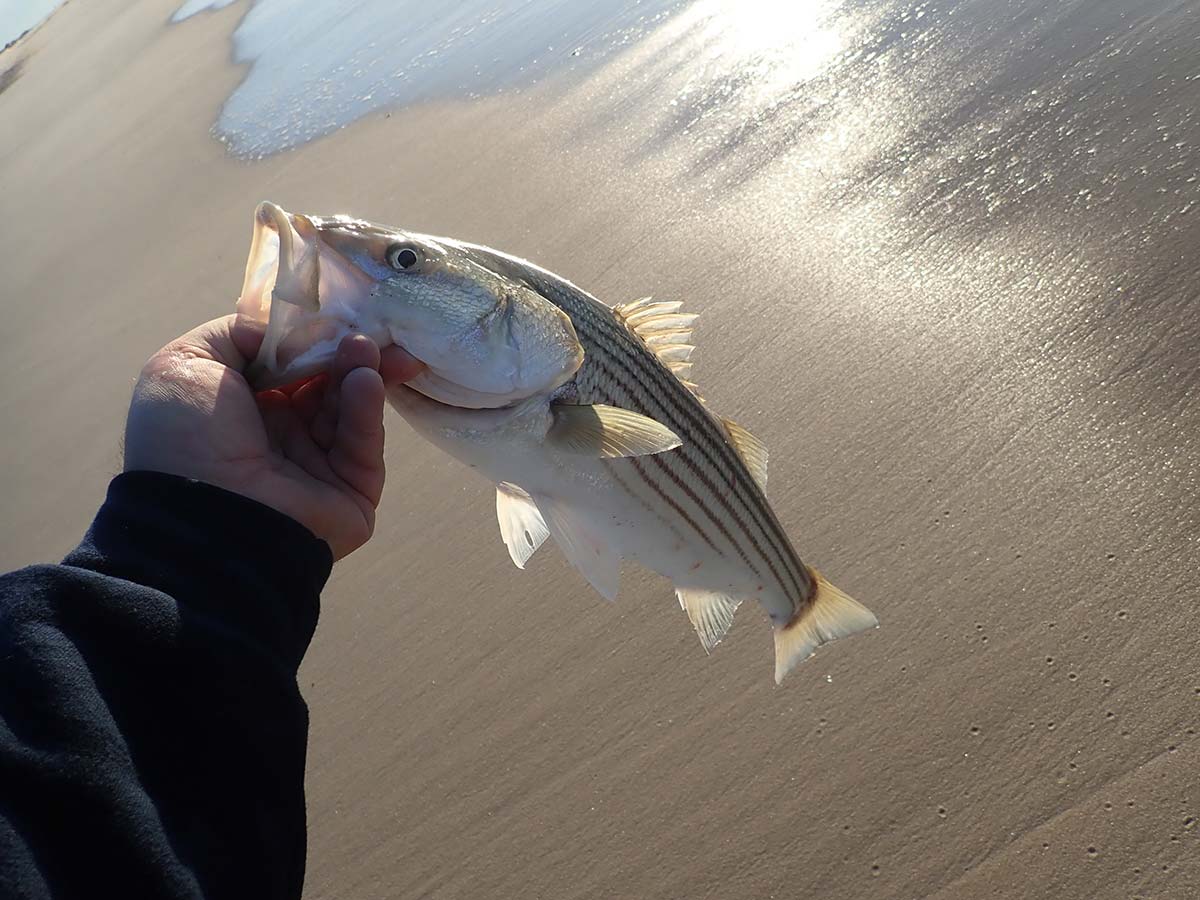
The November surf can provide a good dose of rod bending action before the curtain closes on the season.
The days have gotten shorter, and each dawn brings a biting cold that feels more like winter than fall. Sunrise creeps later each morning, while the climbing sun often illuminates a chaotic scene playing out right at the water’s edge. Bait, bass, and birds all collide a short cast from the sand, giving anglers that brave the cold, fast action through most of the day.
While you may encounter the occasional bruiser, smaller fish typify the last innings of the fall run, but what these fish lack in size they usually make up for in quantity. By matching your tackle to the size of the fish, you can have a great send off before the long winter begins. Downsizing your spinning rod provides great sport with schoolies, as does picking up a fly rod.
Shrink Your Spinner
To ensure healthy releases, and the future of the fishery, you need to use tackle that will bring fish in before they are completely exhausted so they will live to spawn again. But when the fish are measured in inches and not pounds, you can safely step your tackle down a bit. You’ll get more fun out of the battle, and give the fish a fighting chance.

The predators are not the only things that are smaller; the bait is downsized too. Baits like sand eels, white bait and peanut bunker dominate the forage base at the tail end of the fall run. The lures and plugs that mimic these small baits typically only weigh an ounce or two, so look for a rod that can toss lures from about ½ up to 2-½ ounces. Spinning rods in the 8 to 9-foot range fit perfectly in this niche. ODM Rods makes an excellent eight footer that can handle baits as light 3/8 ounce, but has enough backbone to easily whip fish well into the slot.
Use a smaller reel to balance with the rod, but keep in mind that it will get wet. So when you’re downsizing, select a reel built to handle the surf. Tsunami’s Salt X 4000 is a good match, as is Van Staal’s VR50. Spool these up with braid, going light to get as much action as possible out of your baits. I use 15 or 20-pound test Power Pro, but any of the quality braids on the market will do. I also like to go light with my leaders, usually opting for 20-pound test fluorocarbon. If bluefish are in the mix, or your lure starts to tangle on the cast, go up to 40 pound.
Go Fly
The fall run is the perfect time to pick up the fly rod. The smaller baits are perfectly imitated by flies, and the action is often at your feet. With bass and bait right at the lip, you won’t need to the ability to bomb out long casts. And with ample targets, even the most rudimentary casting attempts will be rewarded often enough to keep you coming back for more.
Though it may seem complicated, choosing fly tackle for the fall run along the open beach is actually pretty simple. A 9-foot, 9-weight rod is the workhorse of the Northeast, and it’s perfect for the fall surf. You can easily spend a grand on a fly rod, but you don’t have to. St. Croix makes a variety of excellent rods at realistic price points. Sage recently introduced the Foundation series, which performs like rods costing twice as much.

Sealed reels stand a better chance of making it through a season in the surf than their counterparts, but you can make due with just about anything that will hold 150 to 200 yards of backing and an intermediate line. Because the fish you’re encountering aren’t huge, you don’t need a reel capable of stopping a freight train; you’ll probably play most of the fish by hand. Sealed reels from Van Staal and Waterworks Lamson will last a lifetime, but there are lower priced models from Redington that will fit the bill.
An intermediate line cuts through the surface tension to get below breaking waves, making it a good choice for the surf. Weight forward lines are also a must to fight the ever-present winds. Craig Cantelmo of Van Staal turned me on to Airflo’s Sniper lines years ago and I haven’t used anything else on the beach since. The line places most of the weight in an abbreviated head design, giving you lots of distance with a minimum of false casts. If you aren’t already outfitted with a fly set up like the one mentioned above, head over to your local fly shop and have them set you up.

While trout fisherman need complex leader set ups and delicate tippets, you can skip all that for a day on the brine. Tapered leaders help turn flies over while offering a delicate presentation, but you don’t need to be concerned with a soft landing when you’re dropping a fly into the whitewater. I typically use a 6 to-9 foot trace of 15-pound fluorocarbon as a leader, attaching it to the fly line with a loop-to-loop connection.
Two pieces of gear that I consider a necessity for fly fishing the beachfront are a stripping basket and cohesive bandage tape. The stripping basket keeps your line out of the surf, so it isn’t sucked out with each receding wave. The tape prevents infection. I’ve never been one to tape my hands, but last year I had a cut in the crease of my stripping finger that resulted from playing fish by hand and not on the reel. This cut remained through the end of December. Had I taped it before it got bad, it probably wouldn’t have lasted for months.

Counterfeit Baits
Sand eels are the big story at the end of the fall run. The thin, 3- to 8-inch long baitfish spend the summer offshore, where they provide a buffet for whales and tuna. As the mercury drops around the beginning of November, they come in and stage themselves along the sand beaches. Once sand eels have started calling an area home they tend to stick around a while, so if you find a pod of them you should have good fishing for a couple of weeks before they move on.
If you don’t know what to throw at the end of the run, a plug and teaser combo is always a great place to start. The pair of lures offers two different profiles and presentations that imitate a variety of baits, giving you multiple chances to trigger strikes. This is by far the most productive rig you can use on many days, resulting in double headers.
You can use various plugs depending on where in the water column you’d like to present your teaser. Use a metal lip swimmer to target fish near the top, a diamond jig or other tin for lower. You can use a soft plastic lure, like a Red Gill sand eel imitation, or a fly for the teaser. Choose a teaser to match whatever the smallest bait you believe to be in the area.
There’s a few different ways to rig a teaser, but the simplest involves tying a dropper loop about 20 inches above your lure and attaching the fly or soft plastic. I prefer a slightly more refined rig, tying my braided main line to a barrel swivel. Attach two pieces of 20 pound test fluorocarbon leader material to the swivel’s bottom loop using clinch knots; one about 24 inches in length, the other around 10. Tie the plug to the longer one and the teaser to the shorter and hit the surf.
You may have seen some folks online using more than one teaser. Don’t do this. Two fish on the sand at a time can be a handful, and you need to get them back in the water as quickly as possible to ensure a healthy release. If fish tangle with each other, you’ll be forced to keep them out of the water for too long, jeopardizing their survival.
Probably the most commonly used lure to imitate sand eels is a diamond jig with a surgical tube tail, but needlefish plugs like the Super Strike Super N or the Gibbs Needlefish can be very effective as well. If stripers are harassing them right in the wash, soft plastics like the Tsunami Holographic Sand Eel can be very effective. Fly fishers can’t go wrong with a chartreuse over white Clouser minnow or Mikkleson’s Epoxy Baitfish in size 2 or 1/0, but if you can’t hook up with that tie on an oversized squid pattern. Squid follow the sand eels inshore, and provide a lot more calories in a single bite. Stripers will key in on them, giving you an advantage when the wash is flush with sand eels.
Mullet hit area beaches around the end of September, and tend to stick around until the end of November. When they are in thick, you can usually see the 5 to 8 inch baitfish swimming in cresting waves just before they break onto the sand. They tend to not make much of a commotion, so you will really need to keep your eyes peeled. The mullet run varies greatly in length; some years it’s a week, others a month. If you happen to be at the beach when it’s taking place you’ll be rewarded with some of the fastest action of the year.
To effectively imitate the somewhat broad profile of mullet, spinfishers should use smaller metal-lipped swimmers, like Danny plugs, or pencil poppers that stay near the surface just like the naturals do. If you need to punch into a headwind, consider a tin like the Charlie Graves J-2 or Mullet. Fly anglers should look to wide patterns such as Enrico’s Mullet or Lefty’s Deceiver, tied with a dark back over a light belly.
Peanut bunker, young of the year Atlantic Menhaden, make a fleeting appearance along the open beach anywhere from the middle of October through the New Year. At this time they will about 3 to 6 inches long, making them striper candy. Look for them in pods forming dark spots on the water’s surface. You can even smell them if the wind is right, with an almost melon scent drifting on the wet air. The schools are usually a long cast off the beach, but they’ll be driven up onto the sand by a mass of marauding bass and blues on occasion.
Soft plastic swim shads mimic the profile perfectly, but casting distance is limited by the internal weighting. If you need to get out further, tins like the Charlie Graves or Point Jude Butterfish effectively mimic the deep belly of bunker and have enough weight to reach out. Fly anglers should opt for wide patterns, like Deceivers or Magnum baitfish. The floating Crease Fly features the characteristic deep belly and creates a disturbance on the surface to attract stripers from a distance.

Where-To
If you’re lucky, finding fish will be as simple as following diving birds. If you’re not that fortunate, you’ll want to concentrate your efforts on the gradual structure created by the shifting sands. While reading the beach is a skill that can take years to master, you can pick up the basics fairly quickly. Taking a walk at low tide will help shorten the learning curve, giving you a peek behind the curtain so to speak. And look for the following clues when the water is up
You want to work areas that exhibit some change in depth. Scan the water looking for subtle differences in color; these indicate alterations in topography. Where waves are breaking is another sign, illustrating where a bar ends. The space between the first and second breaker can be very productive, with greedy stripers gobbling up disoriented baitfish. The deeper water between a sandbar and the beach—the trough—is often very productive; so don’t just cast over it.



